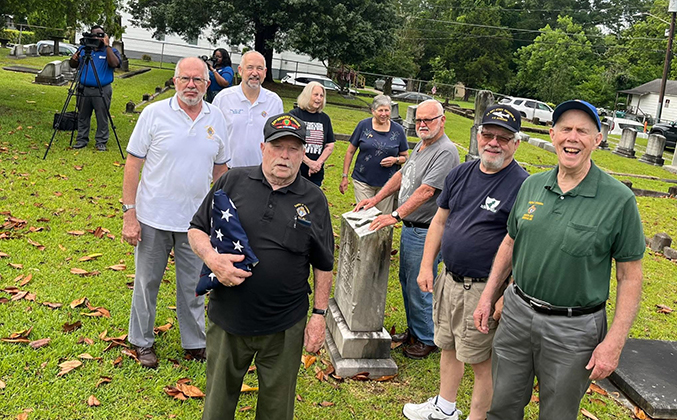
Memorial Day remembrance


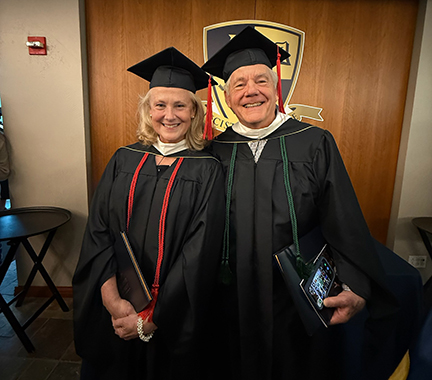
SPIRITUAL ENRICHMENT
BIRMINGHAM, Ala. – Catholic Charismatic Renewal Conference “Come Holy Spirit With Your Fire” on July 25 and 26, featuring Ralph Martin as the main speaker. Details: email Jeannie at Jwade3585@outlook.com or call Ray at 205-999-8947. Register at www.catholiccharismaticrenewal.org.
DIOCESE – Pilgrims of Hope in a Multicultural Church, June 21 at St. Francis Greenwood with speaker Deacon Ted Schreck and June 28 at St. James Tupelo with speaker Sister Carol Prenger. Programs from 10 a.m. to noon, followed by a light lunch. Please register one week before events at https://bit.ly/4jFn7Mi. Details: Sister Amelia Breton at (601) 949-6935 or email amelia.breton@jacksondiocese.org.
GREENWOOD – Locus Benedictus, Inner Healing Retreat – “I have called you by name,” Saturday, June 28 from 8 a.m. to 3 p.m. Presenters: Dr. Sheryl Jones and Joyce Pellegrin. Details: Register via email to contactlocusbenedictus@gmail.com or call (662) 299-1232.
JACKSON – St. Richard, ChristLife: Discovering Christ, begins Wednesday, Sept. 10 and ends Oct. 22 from 6:30-8:30 p.m. in Foley Hall. Retreat on Saturday, Oct. 11. Enjoy a delicious meal, listen to a dynamic teaching that helps people enter into or renew a personal relationship with Jesus Christ, experience the love of God the Father and be empowered by the Holy Spirit to live as God’s children and join in a small group discussion. Register at https://bit.ly/3HvRKGE. Details: call Tiffany at (601) 842-0151.
TUPELO – St. James, Catechesis of the Good Shepherd Level II Adult Formation Course beginning July 17. Mixed format with dates in July and September of 2025 and January, April and June 2026. Course cost $650 per participant; discounts available for parishes sending more than three participants. Details: email karen@stjamestupelo.com.
PARISH, FAMILY & SCHOOL EVENTS
BROOKHAVEN – St. Francis, “True North” Vacation Bible School, July 13-16 from 5:30-8 p.m. Details: email office@stfrancisbrookhaven.org.
CLEVELAND – Our Lady of Victories, “True North” Vacation Bible School for PreK-3 through third grade, June 16-18 from 5:30-7:30 p.m. Details: register online: www.myvbs.org/olvcleveland.
FLOWOOD – St. Paul, Annual Jose’ Lopez Texas Hold’em Tournament, Saturday, June 28 at 6 p.m. in the Family Life Center. Doors open at 5:30 p.m. Buy-in is $25. Details: church office at (601) 992-9547.
GLUCKSTADT – St. Joseph, “True North” Vacation Bible School, June 23-27 from 5:15-8 p.m. in the parish hall. Dinner and games from 5:15-6 p.m. Open to all children entering K through sixth grade. Cost: $15 per child/$30 max per family. Details: https://giving.parishsoft.com/app/stjosephgluckstadt – select one-time donation and then VBS 2025 as the fund.
JACKSON – Holy Ghost, 50th Anniversary of the Knights of Peter Claver Ladies Auxiliary, Saturday, June 21 in the parish life center. Details: Please RSVP for luncheon by call or text to Sandra Lynn at (601) 505-1679.
JACKSON – Catholic Charities, 20th annual Bishop’s Ball, Saturday, July 19 at the Two Mississippi Museums. Cocktail hour at 6 p.m. with an auction at 7 p.m. Live music by the Patrick Harkins Bank. Details: call (601) 355-8634 or visit https://event.gives/bb25.
MADISON – St. Francis, Vacation Bible School, June 23-26 from 9 a.m. till noon. Students ages four through fourth grade are welcome to join the “Prayer Safari” and students in grades fifth through eighth are invited to the “Creativity Kingdom” VBS Creative Arts camp. Details: email mc.george@stfrancismadison.org.
MERIDIAN – St. Patrick, “True North” Vacation Bible School for K through sixth grades, June 23-27 from 8 a.m. to noon in the gym, with lunch provided. Details: register at vbspro.events/p/meridian.
Por Joe Lee
MADISON – Ed Donohoe no tuvo que viajar tan lejos como los familiares del padre Frank Cosgrove, que vinieron desde Irlanda para ver al querido sacerdote celebrar la misa y conmemorar el 60.º aniversario de su ordenación, un evento que tuvo lugar el 2 de junio en la iglesia de San Francisco de Asís, en Madison.
Pero 1200 millas era un largo viaje para Donohoe, y no era un viaje barato. ¿Por qué era tan importante para él unirse a la celebración al otro lado del país?
“Porque el padre Frank era como de la familia”, dijo Donohoe, un residente de Colorado que acababa de presentarse para el servicio en la Estación Aérea Naval Meridian en 2008 cuando se conocieron. El padre Frank, entonces párroco de la iglesia de San Patricio, conducía media hora hasta la capilla de la base para celebrar la misa. No tardaron mucho en hacerse amigos.
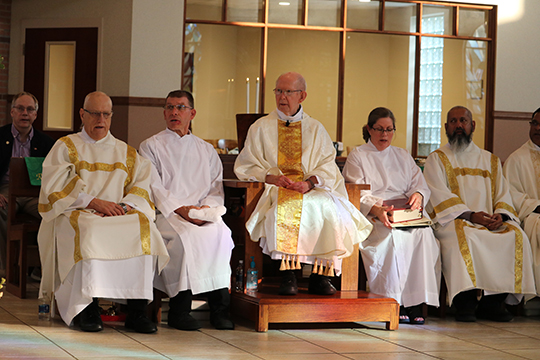
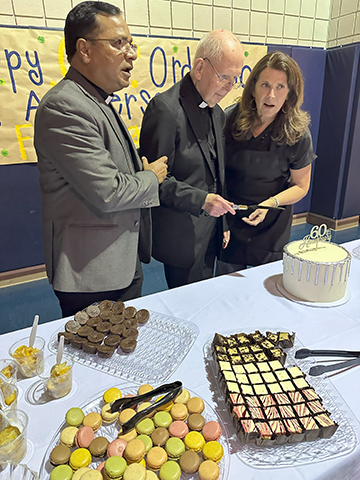
Los miembros de la familia Cosgrove, entre ellos el hermano del padre Frank, Eamonn, su hermana Ruth y sus sobrinos nietos, que visitaban Estados Unidos por primera vez, volaron más de 4000 millas para participar en la misa y disfrutar de la recepción. Más de 50 sacerdotes de todas las diócesis católicas de Jackson y Biloxi acudieron para apoyarlo, y católicos de todo Misisipi (y un número sorprendente de no católicos) abarrotaron el santuario de San Francisco.
Escucharon una homilía basada en sus nuevas memorias, “Sir, Do You Know Where You Are Going?” (Señor, ¿sabe adónde va?), en la que se refirió a menudo a la unidad.
“La celebración significa mucho para mí”, dijo Ralph Eubanks, quien conoce al padre Frank desde que era estudiante en Ole Miss hace dos generaciones, cuando el padre Frank era párroco de la iglesia St. John. “Era un hombre dedicado a la verdad, denunciaba el pecado del racismo y creía en unir a las personas”.
“Casó a mis padres (Ed y Cindy Hannan) hace 48 años”, dijo Anabeth Hannan Duncan, feligresa de St. Francis. “Me bautizó hace 31 años y me casó hace tres años. Pasamos la Nochebuena con él todos los años. Cuando pienso en Dios, veo al padre Frank, imaginándolo unos centímetros más alto”.
“El padre Frank y yo nos conocemos desde 1969, cuando era vicario en St. Peter”, dijo Charlene Bearden. “Me ayudó a conseguir una audiencia con el papa San Juan Pablo II en 1987, cuando estuvo en Nueva Orleans. Lo hizo a través de la National Black Catholic Leadership. Ha influido en la vida de muchas personas de muchas maneras”.
“Lo conozco desde que era adolescente, cuando era nuestro párroco en Ole Miss”, dijo Mary Johnson Coyle. “He sido su amiga durante toda mi vida adulta. Estando con él, uno quería ser mejor católico. Es un hombre encantador y maravilloso que une a todo el mundo”.
“Mi marido John y yo fuimos miembros fundadores de St. Francis”, dijo Mary Kraft. “El padre Frank ha sido maravilloso con nuestra familia. Nuestra hija y otra niña pequeña comenzaron en la CYO en St. Francis bajo su tutela. Nos pidió que fuéramos ministros eucarísticos, pero le dije que nos gustaría ser monaguillos, y fuimos los primeros monaguillos adultos”.
En la recepción celebrada en el centro familiar St. Francis, el padre Frank dedicó tiempo a todos los que querían un abrazo, una selfie o un minuto o dos para darle las gracias. La celebración se prolongó hasta bien entrada la noche. El padre Frank, que ahora tiene más de ochenta años y está afectado por el Parkinson, seguía en pie con una gran sonrisa en el rostro.
Las memorias tuvieron un gran éxito, vendiéndose casi 200 ejemplares en el evento. Están disponibles por 20 dólares hasta agotar existencias en las oficinas parroquiales de San Patricio en Meridian, San Juan en Oxford, San Pablo en Brandon y San Francisco de Asís en Madison.
(Joe Lee es el editor jefe de Dogwood Press y miembro de la parroquia de St. Francis of Assisi, en Madison).
Por Kate Scanlon
WASHINGTON (OSV News) – Este 30 de mayo, la Corte Suprema de Estados Unidos permitió que la administración Trump pusiera fin a las protecciones de deportación para más de 500.000 inmigrantes de Cuba, Haití, Nicaragua y Venezuela – típicamente países de mayoría católica – mientras que una apelación de la orden del presidente sigue pendiente.
Anteriormente, la administración Biden concedió a algunos migrantes de esos cuatro países la posibilidad de entrar legalmente en Estados Unidos por motivos humanitarios, alegando condiciones peligrosas en sus países de origen. Tras el regreso del presidente Donald Trump a la Casa Blanca, su administración revocó ese permiso (conocido como “parole humanitario), lo que provocó un desafío legal. Un juez federal bloqueó previamente que la administración Trump pusiera fin al programa.
La orden no firmada no explicaba el razonamiento de la mayoría.
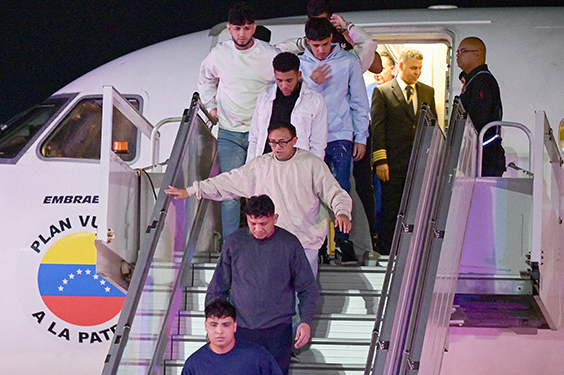
En una opinión disidente, el juez Ketanji Brown Jackson, junto con la juez Sonia Sotomayor, reprendió a la mayoría del alto tribunal en la decisión, argumentando que “claramente estropearon” su evaluación.
“No exige casi nada al Gobierno con respecto al daño irreparable”, escribió Jackson. “Y subestima las devastadoras consecuencias de permitir que el Gobierno ponga fin precipitadamente a las vidas y medios de subsistencia de casi medio millón de no ciudadanos mientras sus reclamaciones legales están pendientes”.
“Incluso si es probable que el Gobierno gane en los méritos (del caso), en nuestro sistema legal, el éxito lleva tiempo y las normas de suspensión requieren más que una victoria anticipada”, escribió Jackson.
Ya en marzo, la Conferencia de Obispos Católicos de Estados Unidos calificó la terminación del programa CHNV, como se le conoce por las letras de los países de los migrantes en ese programa, de “contraproducente” para los objetivos declarados de la administración Trump de promover el respeto por el estado de derecho y reducir la presión sobre las comunidades estadounidenses.
“Instamos a la Administración a considerar el impacto adverso de esta acción sobre los ciudadanos y no ciudadanos por igual, especialmente teniendo en cuenta las condiciones actuales en varios de los países implicados”, dijo la portavoz de la conferencia episcopal de EE.UU., Chieko Noguchi, en una declaración proporcionada a OSV News.
La doctrina social católica sobre inmigración, explicada por la la conferencia (USCCB por sus siglas en inglés), equilibra tres principios interrelacionados: el derecho de las personas a emigrar para mantener sus vidas y las de sus familias, el derecho de un país a regular sus fronteras y controlar la inmigración, y el deber de una nación de regular sus fronteras con justicia y misericordia.
J. Kevin Appleby, investigador principal de política del Centro de Estudios sobre Migración de Nueva York y ex director de política migratoria de la USCCB, dijo a OSV News: “Es particularmente preocupante que la administración se dirija a inmigrantes que fueron invitados a los Estados Unidos y entraron legalmente”.
“También provienen de países con regímenes opresivos y podrían ser objeto de persecución cuando sean devueltos”, dijo Appleby. “Muestra cierta hipocresía, ya que la administración califica a los inmigrantes de criminales pero sigue deportando a los que cumplen las normas”.
Appleby dijo que los individuos de otras naciones podrían haber sido tratados de manera diferente.
“Seamos sinceros, si este programa sirviera a inmigrantes de Noruega, Suecia o a los afrikaners de Sudáfrica, la administración no estaría intentando ponerle fin”, dijo.
En efecto, la decisión de la Corte Suprema significa que el Departamento de Seguridad Nacional puede revocar el estatuto de protección de estas personas mientras la Corte de Apelaciones del 1er Circuito de EE.UU. sopesa un recurso contra la propia orden.
El fallo de ese tribunal sigue pendiente.
(Kate Scanlon es una reportera nacional de OSV News que cubre Washington D.C. Síguela en X @kgscanlon.)
AUSTIN, Texas (OSV News) – El fiscal general de Texas, Ken Paxton, puede seguir investigando Annunciation House (la Casa de la Anunciación) de El Paso, una organización católica sin fines de lucro que sirve a los migrantes, dijo la Corte Suprema de Texas el 30 de mayo. Desde febrero de 2024, en presentaciones judiciales y declaraciones a la prensa, la oficina de Paxton ha tratado de cerrar Annunciation House, alegando que la organización facilita el cruce ilegal de fronteras, oculta “extranjeros presentes ilegalmente de la aplicación de la ley”, y no entregó los documentos que la oficina buscaba en su investigación. Sin embargo, Annunciation House y sus abogados negaron haber cometido infracciones o conductas ilegales y afirmaron que la oficina de Paxton no siguió los procedimientos legales adecuados para solicitar documentos a la organización. En julio, un juez estatal denegó el intento de Paxton de cerrar la organización sin ánimo de lucro, al considerar que su oficina “no había establecido motivos probables” para ello, argumentando que había violado la Ley de Restauración de la Libertad Religiosa de Texas, entre otras cuestiones. Poco después, Paxton apeló directamente al más alto tribunal del estado para reactivar su iniciativa. Una decisión escrita por el juez de la Corte Suprema de Texas Evan A. Young dijo que la naturaleza de la apelación directa significa que “debe abordar esta controversia mucho antes de lo que normalmente lo haría”, argumentando que inicialmente considera que un tribunal inferior fue “prematuro” en el bloqueo de la iniciativa de Paxton.
Por Obispo Joseph R. Kopacz, D.D.
En el primer domingo de Pentecostés, el Espíritu Santo levantó a Pedro y a los 11 apóstoles de en medio de los otros discípulos, incluida la Santísima Madre, todos los cuales estaban encendidos con el fuego del amor de Dios.
Desde el corazón de la Iglesia de la Nueva Alianza, Pedro se dirigió a la multitud reunida en Jerusalén con el primer anuncio del Evangelio de Jesucristo, crucificado y resucitado.
Casi 2,000 años después, en un escenario muy diferente, el sucesor de Pedro, el Papa León XIV, levantado por el Espíritu Santo desde el corazón de la Iglesia y rodeado de muchos sucesores de los apóstoles, sus hermanos cardenales y obispos, se dirigió a la multitud y no solo los reunidos en Roma, sino también a los cientos de millones de personas en todo el mundo con las palabras del Señor crucificado y resucitado. “La paz sea con vosotros”.
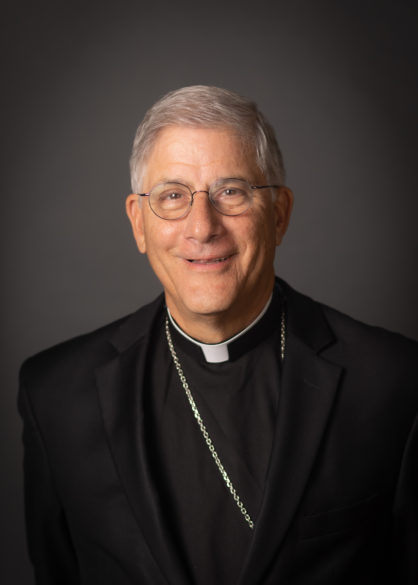
¿Qué otro jefe de Estado tiene un impacto tan esperanzador al inicio de su cargo público?
A la mañana siguiente, en la Capilla Sixtina, donde el Espíritu Santo guio a los cardenales que habían elegido a León XIV, el Santo Padre celebró la Misa y compartió sus primeras reflexiones sobre su visión de la Iglesia, y el Cuerpo de Cristo. A menudo está fuera de lo habitual con la consideración a la resistencia del mundo a la Buena Noticia, mientras que al mismo tiempo se esfuerza bajo el peso y el anhelo irresistible de lo que el mundo no puede dar.
El Papa León predicó lo siguiente en su primera homilía: “De modo particular, Dios me ha llamado por tu elección para suceder al Príncipe de los Apóstoles, y me ha confiado este tesoro para que, con su ayuda, pueda ser su fiel administrador (cf. 1 Corintios 4:2) por el bien de todo el Cuerpo místico de la Iglesia. Lo ha hecho para que sea cada vez más plenamente una ciudad firme sobre una colina (cf. Apocalipsis. 21:10), un arca de salvación que navega por las aguas de la historia y una luz que ilumina las noches oscuras de este mundo.
“Y esto, no tanto a través de la magnificencia de sus estructuras o la grandeza de sus edificios -como los monumentos entre los que nos encontramos-, sino más bien a través de la santidad de sus miembros. Porque nosotros somos el pueblo que Dios ha escogido como suyo, para que contemos las maravillas de aquel que nos llamó de las tinieblas a su luz admirable”. (cf. 1 Pedro 2:9)
En realidad, todos los bautizados que son templos del Espíritu Santo, hermanos y hermanas del Señor Jesús e hijos de Dios participan en esta misión.
Mirando con medida al mundo que ha amado profundamente, el Papa León XIV reflexionó: “Hay contextos en los que no es fácil predicar el Evangelio y dar testimonio de su verdad, donde los creyentes son burlados, opuestos, despreciados o, en el mejor de los casos, tolerados y compadecidos. Sin embargo, precisamente por esta razón, son los lugares donde se necesita desesperadamente nuestro alcance misionero. La falta de fe a menudo va acompañada trágicamente de la pérdida de sentido de la vida, del descuido de la misericordia, de las terribles violaciones de la dignidad humana, de la crisis familiar y de tantas otras heridas que afligen a nuestra sociedad”.
Las palabras del Papa León resonaron en toda la Capilla Sixtina en esa primera mañana y continuarán resonando en la Iglesia y en el mundo durante su papado. Donde se encuentra en medio del espíritu en este maravilloso Año Jubilar de Esperanza, una esperanza que no defrauda porque “el amor de Dios ha sido derramado en nuestros corazones por el Espíritu Santo”. (Romanos 5:5)
En Pentecostés y siempre, el Papa León nos recuerda que “cuanto más nos dejemos convencer y transformar por el Evangelio, permitiendo que la fuerza del Espíritu purifique nuestro corazón, que nuestras palabras sean directas, nuestros deseos honestos y claros, y nuestras acciones generosas, más capaces seremos de proclamar y vivir su mensaje”.
Que el Espíritu Santo siga colmando la Iglesia y al mundo con la esperanza y la paz que el mundo no puede dar.
By Cindy Wooden
CIUDAD DEL VATICANO (CNS) – Ser religioso no significa automáticamente que alguien sea compasivo, y sin embargo para un cristiano la compasión es un signo claro de seguir a Cristo, dijo el Papa León XIV.
“Antes que una cuestión religiosa, ¡la compasión es una cuestión de humanidad! Antes de ser creyentes, estamos llamados a ser humanos”, dijo el Papa el 28 de mayo durante su audiencia general en la Plaza de San Pedro.
Al final de la audiencia, el Papa León abogó de nuevo por la paz en Gaza y en Ucrania.
“Desde la Franja de Gaza se eleva al cielo, cada vez con mayor intensidad, el grito de madres y padres que, abrazados a los cuerpos sin vida de sus hijos, se ven obligados continuamente a desplazarse en busca de algo de comida y un refugio más seguro de los bombardeos”, dijo el Papa. “A los dirigentes, renuevo mi llamado: Cesen los disparos; liberen a todos los rehenes; respeten plenamente las leyes humanitarias”.

Y tras días en los que Rusia ha incrementado sus ataques contra Ucrania, matando civiles y destruyendo infraestructuras, el papa aseguró al pueblo ucraniano su “cercanía y mis oraciones por todas las víctimas, especialmente los niños y las familias”.
“Renuevo con fuerza mi llamamiento para detener la guerra y apoyar toda iniciativa de diálogo y de paz”, dijo. “Pido a todos que se unan a las oraciones por la paz en Ucrania y dondequiera que la gente sufra a causa de la guerra”.
La catequesis principal del Papa en la audiencia se centró en la parábola del buen samaritano, una historia que, según el Papa, ofrece importantes lecciones para los cristianos, pero también es fuente de esperanza.
“La falta de esperanza, a veces, se debe a que nos quedamos atrapados en una cierta forma rígida y cerrada de ver las cosas, y las parábolas nos ayudan a mirarlas desde otro punto de vista”, dijo el Papa León.
La parábola del buen samaritano es una lección evidente sobre la compasión y el reconocimiento del prójimo. Pero también dice algo sobre la compasión de Jesús.
“También podemos vernos a nosotros mismos en el hombre que cayó en manos de los ladrones, porque todos hemos experimentado las dificultades de la vida y el dolor provocado por el pecado”, dijo en su resumen en inglés. “En nuestra fragilidad, descubrimos que Cristo mismo es el Buen Samaritano que cura nuestras heridas y restaura nuestra esperanza”.
El hombre herido al borde del camino “nos representa a cada uno de nosotros”, dijo, y recordar “todas las veces que Jesús se detuvo para cuidar de nosotros nos hará más capaces de compasión”.
Ser compasivo, dijo, no es sólo un sentimiento; significa pasar a la acción.
La parábola, dijo el Papa León en su resumen en español, está dirigida a un alguien que, a pesar de conocer las Escrituras, considera la salvación como un derecho que le es debido. Esta parábola “le ayuda a cambiar de perspectiva, y a pasar de centrarse en sí mismo a ser capaz de acoger a los otros, sintiéndose llamado a hacerse prójimo de los demás, sin importar quienes sean, y no sólo juzgar cercanas a las personas que lo aprecian”.
“La parábola gira en torno al camino que hace cada personaje, al modo de aproximarse a los demás y a cómo se comporta cada uno cuando ve al prójimo en dificultad”, continuó el Papa. “El texto nos pide reflexionar sobre nuestra capacidad de detenernos en el camino de la vida, de poner al otro por encima de nuestra prisa, de nuestro proyecto de viaje”.
“Si quieres ayudar a alguien, no puedes pensar en mantenerte a distancia, tienes que implicarte, ensuciarte, quizás contaminarte”, dijo el Papa, señalando que, en la parábola, el buen samaritano limpia y venda las heridas del hombre y lo lleva a un lugar seguro.
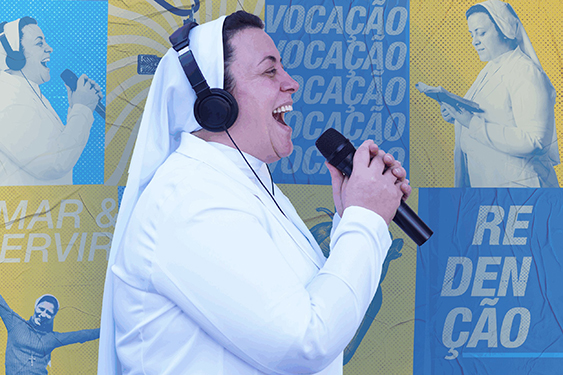
NACIÓN
CIUDAD DE OKLAHOMA (OSV News) – Se insta a los católicos a asistir en gran número a los eventos de la Peregrinación Eucarística Nacional, a medida que aumentan las protestas anticatólicas a lo largo de los 5.380 kilómetros de la Ruta de Santa Catalina Drexel. Los manifestantes, muchos de ellos de la Iglesia de Wells en Wells, Texas, han atacado las procesiones eucarísticas, denunciando las creencias católicas, en particular la presencia real de Jesús en la Eucaristía. Hasta 50 manifestantes, entre ellos niños, se enfrentaron a los peregrinos en Oklahoma entre el 30 de mayo y el 2 de junio. Los organizadores esperan que aumenten las manifestaciones a medida que la peregrinación de 36 días avance por Texas y California. “Esto es caminar con nuestro Señor contra los ataques”, dijo Jason Shanks, presidente de National Eucharistic Congress Inc., instando a los católicos a dar testimonio con valentía pero de forma pacífica. Desaconsejó enfrentarse a los manifestantes y hizo hincapié en la oración, la humildad y la caridad. La peregrinación, que comenzó el 18 de mayo en Indianápolis, incluye paradas diarias para la misa, la adoración y el servicio. Los organizadores están vigilando la seguridad, pero no han modificado el programa. Estableciendo un paralelismo con el camino de Jesús por la Vía Dolorosa, la ruta que recorrió llevando la cruz en Jerusalén hasta su crucifixión y muerte, Shanks dijo que los peregrinos están recorriendo “el Camino de la Cruz”.
VATICANO
CIUDAD DEL VATICANO (CNS) – Aunque el papa Francisco ya fijó el 3 de agosto como fecha para declarar la santidad del beato Pier Giorgio Frassati, el papa León XIV celebrará una reunión con los cardenales para aprobar su canonización y la de otras siete personas. La reunión, conocida como “consistorio público ordinario”, está prevista para el 13 de junio, según ha anunciado el Vaticano. Los cardenales que viven en Roma o están de visita en la ciudad están invitados a participar en el consistorio, que suele ser un servicio de oración que incluye la lectura de una breve biografía del candidato a la santidad, la solicitud del papa a los cardenales para que aprueben la canonización y, por lo general, el anuncio de la fecha de la ceremonia. Dado que la canonización del beato Carlo Acutis, prevista para el 27 de abril, se pospuso tras la muerte del papa Francisco, es posible que, junto con el consistorio, el Vaticano anuncie una nueva fecha para proclamarlo santo.
MUNDO
SÃO PAULO (OSV News) – Dos monjas brasileñas se han vuelto virales en todo el mundo después de que un vídeo del 28 de mayo las mostrara haciendo beatboxing y bailando hip hop en la televisión católica, lo que ha provocado comparaciones con la película “Sister Act”. Las hermanas Marizele Isabel Cassiano Rego y Marisa de Paula Neves, de las Hermanas de la Copiosa Redención, estaban promocionando un evento vocacional en la cadena Pai Eterno cuando se lanzaron a una animada actuación llena de fe. El vídeo, grabado el 20 de mayo en el estado de Goiás, llamó la atención de celebridades como Viola Davis y Whoopi Goldberg, que elogiaron su alegre testimonio en el programa “The View” de la ABC. Conocidas por utilizar la música y la danza en su ministerio con drogadictos, ambas hermanas afirman que la evangelización creativa ayuda a romper estereotipos y a conectar con los jóvenes. “La gente piensa que las monjas son rígidas”, dijo la hermana Marizele a OSV News. “Pero cuando nos ven cantar y bailar, ven quiénes somos realmente”. Su enfoque vibrante está inspirando ahora a los jóvenes a ponerse en contacto con la Iglesia.
Vírgenes y Santos
Día de la Bandera
14 de junio
Día del Padre
15 de junio
San Romualdo, abad
19 de junio
Santísimo cuerpo y Sangre
de Cristo
22 de junio
Natividad de San Juan Bautista
24 de junio
Sagrado Corazón de Jesús
27 de junio
CorazónInmaculado de la
Bienaventurada Virgen María
28 de junio
Santos Pedro y Pablo, Apóstoles
29 de junio
Santo Tomas, Apóstoles
3 de julio
Día de la Independencia de los
Estados Unidas
4 de julio
Síganos en Facebook:
@DiócesisCatólicadeJackson
Únase a lista de correos
electrónicos
Mande un texto: MSCATHOLIC a
84576
Especial de
Sacramentos
Mississippi Catholic
publicará una edición
especial de Sacramentos
(Spring Sacraments) en julio.
Necesitamos fotos de
Primera Comunión y
Confirmación.
Envie fotografías grupales a
Mississippi Catholic.
La fecha límite final para las
presentaciones es el
viernes 7 de julio.
editor@jacksondiocese.org